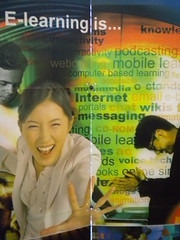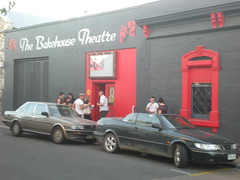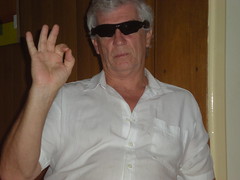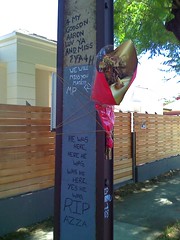
EDAYZ (SA)
Martin Westwell
• we are now answer rich and question poor
• socialisation has emerged as the primary reason fro using the Net, not information transmission
• violent games DO cause violent behaviour, but can develop 'attentional capacity’
Mark Drechsler (Netspot)
• Moodle partners contribute to the funding of Moodle
• BOOK Module allows printing of blocks of content
Nancy White
• In contrast to Communities, Networks more objectified; less about the persona; community more about ‘we’n, networks about ‘me’
• we need to create content or we'll miss out; we communicate because of content
Julian Ridden (Moodle)
• if there is no personal connection for student they will fail
• consider removing institution branding to maake students feel like its theirs!!
TASMANIA
Clint Smith - How to write an Innovations Application
1. sus out the funding body (what do they want out of it?)
2008-11: emphasis on increasing capacity to deliver, and delivering more courses
2. pick the right track (business partnerships, or empowering learners; about 50% funding in each)
business partnerships: you're delivering to employees; should build on an existing relationhip; often elearning 1.0 (ie not facilitated)
empowering learners: ie enrolled students; about embedding elearning in an RTO; extending market reach; usually facilitated learning ie not self-standing; should have a target group
• show you've done the r and d; that you’re ready to go, and have got the skills and a plan
• main outcome is a successful elearning delivery solution
• count e-posteriors (ie virtual bums on seats)
• state where this is leading
Tip 5 - Innovations : explain the change
could be business development OR delivery approaches (emphasis is more on business development)
Survey on why people did previous projects revealed that 57% were about developing content
Tip 6 Design - Provide an e-solution
(refer to Designing eLearning site) http://designing.flexiblelearning.net.au/
Types of Corporate learning
• self-paced
• informal learning
(conclusion - it will be a range of solutions with a variety of tools ie not a single solution)
most common form = blended and support (47%)
facilitated online quite rare (13%)
why add facilitation to elearning offerings?
• assessment
• gp learning
• support
• more motivating
Cathy Moore Workshop
don't state the obvious; get them to DO things
Check readability Indices in spellcheckers
aim for a readability index of around 65
use more verbs, shorter sentences, more people; use active rather than the passive voice
“happiness is boring?” - add people to the scenario and make them suffer!
Ideally use real-world stories
Brad Beach : Tips for Online Facilitation
• is the blended learning model the best model? Or just an excuse to just not do wholly online?
• Who has ever been through a course and neither the teacher nor students said a word?????? So - respond!
Online Community
• community or network? Me or we? Me more related to community
• when trying to work out what is good online practice Brad likes to think back to f2f situations as a reference point
Creating an engaging Discussion Topic
• begin with statement or summary
• ask a single question
• discussion topics in asynch forums more suited to debate rather than content or 'concept clarification' ; ie convergent or divergent thinking; convergent better in real time
Lurking
• even if it is your preferred learning style you should be challenged to try some other method
• a teacher would not allow someone to sit f2f silent for extended periods, so don't online either
WA
Central Institute of Tech (Jeremy Sorensen and ???)
See-Fit Project (not content creation)
• use technology to support trainees (metro and rural)
• used POV, real time OL vid assessment
• vid evidence can be transferred to other contexts (email, YouTube, DVD, etc) and can be used for auditors
• video exemplar - great idea; shows students exactly what is needed for assessment
(YouTube owns the copyright of uploaded content.)
Cyber Assessment (SW Regional TAFE)
Online workplace delivery and assessment; used Moodle, Elluminate and POV glasses, and SMS (no content creation as main focus, but Moodle courses were created in)
Building Studies
Childcare
Metal Trades
Science
Seems like a project where people learnt to teach online/study online, but I wonder how many teachers were involved?
SMS communication draws an immediate response from students! (unlike other channels)
Digital Dogging and Rigging (Sandra Downes) ) Great Southern TAFE
Used the Learning Table (approach) for RFID tags to trigger media
(seems to be content creation; albeit sexy content creation using cutting edge technology)
Sewing program also uses RFID tags for triggering videos
e-Compliance (Abby Chasen; from HBF)
• Gen Y unhappy with current training delivery; dispersed workforce
• not sure, but it's content creation!! boring content was put online (but she says it's interactive...)
VICTORIA
Andrew Douch - ICT Innovations at Secondary College in Victoria
• has won MS Innovative Teacher of the Year Award
• 2 changes in the world and they are converging
• to date, ed has emphasised the left brain (logical, sequential � Maths, Physics, English etc) > left brained careers (Doctor, lawyer etc) ie NOT actor, artist, musician etc
• rise of machinery (took over the role of human strength) and promoted knowledge economy
• here's the Gen Y 'need to be connected story again – is it true, or just a stereotypical view?
• uses MSN with his kids after hours
• use ipadio for phone blogging
• took 3 weeks for his biology podcast to reach #1 on iTunes! With no IT training or tech skills
• 1 minute of Andrew's time = hours for students ie many students can listen to podcast over and over
• simple audio (mp3 tool)
• we need to change assessment methods
• @andrewdouch (Twitter)
Participatory Change - Uni of Ballarat
• using a mentor model - people get 1.5 days/week to improve skills
• but has also realised that PD workshops don't go anywhere (creates a sense of dependence)
• the trick is to get people to realise that they have a role in what elearning looks like in the future!!!!!; referred to the concept of 'consciousization'
Wolf Cocklin - How the ABC Uses Twitter
• Twitter - a combination of stalking, ADHD, and narcissism
• ABC uses Twitter for reporting, monitoring, broadcasting, engaging








